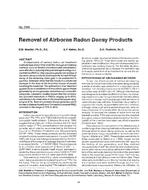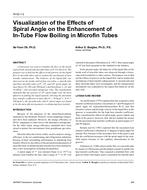Historically, HVAC performance has implied primarily temperature and humidity control – with the qualitative objective being to provide “comfort”. While energy savings and protecting the environment are the first things that come to mind when describing the virtues of “green buildings”, it is commonly acknowledged by organizations such as the U.S. Green Building Council (USGBC) that as much as 70% of the economic benefits of “high performance” (“green”) buildings are attributable to improving indoor environmental quality and the impact that it has on improving occupant health and mental performance. Increasingly, indoor air quality (IAQ) improvements will be a primary performance driver of HVAC systems.
In recognition of the increasing importance of indoor air quality, both the USGBC and ASHRAE are recommending changes to IAQ standards. These changes include increases in air ventilation rates and the expanded use of energy recovery ventilation (ERV) technologies [19, 20]. These changes also include improvements in particulate filtration performance and a call to establish airborne contaminant metrics by which the “quality” of indoor air can be quantified and the “freshness” of outdoor ventilation air can be measured. This increase in emphasis upon indoor air quality is long overdue. We spend the majority of our time living indoors, where the air quality can be much worse than outdoors. Many of us work in environments that actually slow us down and dull our mental alertness. These impacts are subtle and not always constant, but they can represent large cost impacts in the workplace. While we are jogging and flossing and watching our cholesterol, we may be breathing indoor airborne contaminants that can cause chronic illness or in the worst case death… and as a community, we don’t even measure them.
This presentation will discuss new IAQ technology and product trends that simultaneously improve both energy efficiency and indoor air quality. Today, in lower-tier markets, HVAC equipment is often viewed as a “commodity” – where mechanical system components are defined by the lowest common denominator of performance and cost. In the future, high-performance HVAC systems will be understood to be one of the most significant and important investments that can be made, with high returnon- investment (ROI) potential for the purchasers, significant well-being improvements for the users, and higher sales volume and profit margins resulting for the manufacturers.
But to achieve these changes, the HVAC industry must change. We must do a far better job of educating the public regarding indoor air quality. And we must raise our own “standards” regarding performance, reliability and maintainability of HVAC systems. ASHRAE can and will play an important role in achieving such change and can serve as a forum from which we change our definition of air “conditioning”. That new definition will embody a far more complex set of HVAC performance metrics and customer expectations – where safety, health, productivity, and yes comfort, are the objectives.
IAQ 2007 Conference held in Baltimore, Maryland, October 14-17, 2007
Units: SI
Citation: IAQ Conference: IAQ 2007: Healthy and Sustainable Buildings
Product Details
- Published:
- 2008
- Number of Pages:
- 6
- File Size:
- 1 file , 410 KB
- Product Code(s):
- D-IAQ2007-06


